|
Classic Camera Collectors Club
OLD CAMERAS |
ZEISS
1. The beginning

Carl Zeiss is born in Weimar on 11 september 1816.
Carl went to school in Weimar and afterwards went to Dr. Fredrick Koerner, who was researching what kinds of glass were fit to be used in telescopes,
After this apprenticeship Carl Zeiss worked at Jena University for a short time. It was here that he began to study how to build lenses.
In the following 7 years he travels around in Stuttgart, Darmstadt, Berlin and Vienna and visits everyone who has something to do with glass. During this time he makes extensive notes of everything that has to do with the melting of glass, the substances that are used, the making of glass, of lenses and of all optical instruments.
After this he goes back to Jena University to study mathematics and chemistry.
In 1846 he begins a workshop to make magnifying glasses and simple microscopes in the Neugasse at Jena. In 1858 he begins the rpoduction of more sophisticated microscopes. These instruments soon become known for their high quality. In 1861 Carl Zeiss wins a gold medal at the general Exhibition in Thuringen.
Until then Carl Zeiss is doing all the research by an empirical method. The production of a new lens was done by trial and error. Making a new lens meant that all kinds of parameters were changed and changed again until the result was satisfactorial. This method was slow and costed a lot of effort and material.
Carl Zeiss was convinced that a more scientific approach would be better and would give in a technically better and an economical more rentable result.
Hew tried to do it himself for 5 years with no remarkable results. But in 1866 he met Ernst Abbe who was teaching at Jena University.
2. The cooperation with Abbe and Schott
 The 21 year old Abbe (born 23 januari 1840 at Eisenach) had graduated at the university of Goettingen.
In 1863 he got a job in Jena University and in 1870 he was elected proffesor inmathematics and physaics.
The 21 year old Abbe (born 23 januari 1840 at Eisenach) had graduated at the university of Goettingen.
In 1863 he got a job in Jena University and in 1870 he was elected proffesor inmathematics and physaics.In 1878 he became director of the astronomical and meteorologcal observatoria.
In 1866 Abbe met Carl Zeiss and they started a cooperation in the scientific research on better optical products.
In 1872, after 6 years of research on new kinds of glass, they finally made a compound microscope of unequalled quality. This instrument is the forerunner of all the modern microscopes.
A year later Abbe publishes an article in which he explains the mathematics about this microscope.
It was the first time that abberration, diffration and coma in an optical system were so clearly defined.This article remains the base for the understanding of optical science. To thank him for his efforts Abbe was made a partner in the growing Carl Zeiss company.
 In 1879, in order to make their microscopes even better, Abbe recruited a new researcher.
In 1879, in order to make their microscopes even better, Abbe recruited a new researcher.Frederick Otto Schott was studying the use of lithium in a new kind of glass and he contacted Abbe about this.
Abbe was very interested. The new glass gave excellen results and Abbe wrote to Schott to congratulate him.
The result was that Schott made this glass exclusively to be used in Carl Zeiss instruments and in 1884 Zeiss, Abbe and Schott founded a glass factory. That became Schott and Genossen Glass werke Jena.
Schott developped more than 100 kinds of optical glass and besides that also many types of decorative and functional glass. The Jena glass factory became the most famous glass factory in the world.
3. The Carl Zeiss Foundation
In 1888 Carl Zeiss died and his son became co-owner of the company. But he was not interesed and sold his stock to Abbe.
Abbe was a very social man and in 1889 he reformed the company and formed the Carl Zeiss Foundation. The majority of the stock was given to Jena university. The foundation had rules that were made by Ernst Abbe. All the rights and duties were clearly regulated. The workers had an 8 hour working day and some paid holidays. They had a kind of insurance in case of illness or invalidity and they had a pensionfund. It was also forbidden to discriminate people on grounds of race, political conviction, religion, way of life. Such a humanistic approach was very exceptional at the end of the 19th century.
Abbe really was a genius. His whole life he did research on optical systems and he produced practical products that meant a big leap forward for modern microscopie and photography.
Some examples of his discoveries:
- the diffraction-effect with small lens opening
- a lens without spherical abberration
- the fenomenon of lenscoma
- lenses containing fluorite to correct for chromatic abberration
- the apo-chromatic lens
- the sub-stage condensor system for microscopes
- the optical dilatometer to measure the thermical expansion of solid materials
- the system ofnumerical aperture of microscopical lenses
- the use of immersion lenses
4. Camera lenses
In 1890 the Carl Zeiss Foundation started the production of camera-lenses.
The PROTAR was the first photographical lens designed by Dr.Paul Rudolph. This lens was an anastigmat.
In 1896 Dr. Rudolph designed the legendary PLANAR.
This lens is still used in for example the new Contax G2 and also in the Hasselblad mid-format camera.
The Planar design soves the problem of sferical abberation and astigmatism perfectly because the lens is fully symmetrical built. The PLANAR is probably the most copied lensdesign ever.
Using the calculations of Dr. Rudolph another design called TESSAR was made in 1902.
This lensdesign got the nickname Eagle Eye because of the extra-ordinary resolution and the excellent contrast. The TESSAR is also a rather simple design : 4 elements in 3 groups.
Tessar type lemses were made by almost evry lensmaker and they are still produced because of their great qualities : simple construction, high resolution, very good contrast, little abberration.
Ernst Abbe died in 1905 and at that time the Carl Zeiss Foundation was already a big industrial firm. In 1919 Schott donated his stock of Schott and Genossen Werke to the Carl Zeiss foundation.
5. Zeiss Ikon AG
In 1925 Leitz produced the 35mm camera named Leica. This little camera was an instant success.
The Carl Zeiss Foundation reacted quickly. They bought 4 small camera firms namely :
Ica, Contessa-Nettel,Ernemann en Goerz.
These 4 firms were merged into Zeiss Ikon AG.
In the following years Zeiss Ikon produced a lot of different cameras, but they did not manage to make a camera that could compete with the Leica immediately.
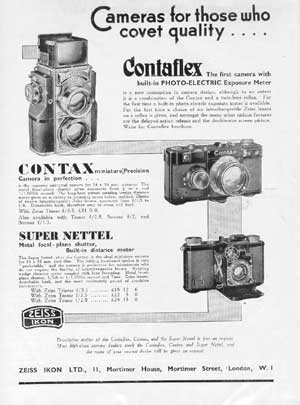
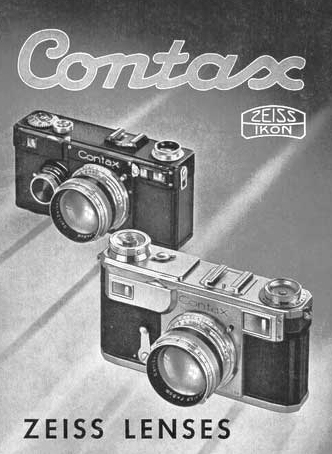
This was a real topper :
- a rangefinder camera with a base of 100mm (the largest ever made)
- a shutter with 11 metal blades and with a topspeed of 1/1000 sec
- changeable lenses with a bayonet
- a choice of lenses from 28mm to 500mm
- a removable back for easy film input
The Contax was made from 1932 to 1938.
In 1936 the Contax II was produced along with the Contax III who had an in-built lightmeter.
These cameras were made until the end of World War II.
The Contax II was also used as a model to design a single lens reflex (SLR) camera. Due tot he war this research was stopped and all the prototypes were lost.
In 1945 the Dresden Camera Werke were bombarded and destroyed completely.
Jena was taken by the troops under general Patton but the Americans had an agreement with Russia and withdrew. Dresden and Jena came under Russian occupation.
But many of the workers and the full board of directors of the Carl Zeiss Foundation went away with the American troops. They were all brought together in Stuttgart in the Contessa Werke.
One of the first decisions the board of Carl Zeis foundation made was to switch the headquarters of the Foundation from Jena to Stuttgart. This way the Carl Zeiss Foundation became a totally West-German company.
The Russians dissassembled the factories in Jena and took all the machinery to Russia. That became the KIEV factory who made low-quality copies of the Contax and other Zeiss Ikon cameras.
The research in Russia and in the West went two different ways : the Russians wanted to develop a single lens reflex camera and the West was more interested in further developing the Contax rangefinder camera.
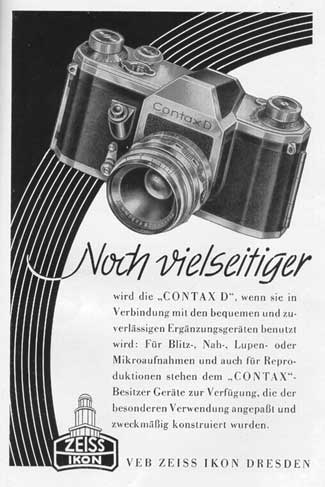
6. From East-German Contax tot Pentacon
In 1949 at the Messe in Leipzig Carl Zeiss Dresden showed the first 35mm single lens reflex with an in-built pentaprism. This was the Contax S. An important difference with the earlier Contax was that the shutter was changed to a horizontal cloth shutter. This was done to make the camera smaller.
In 1952 the Contax S was followed by the Contax D.
The 'D' refers to Dresden, to show that this is a camera made in East-Germany.
The Contax D was not very different from the Contax S : the flash synchronisation is a bit faster and the shutter is quieter.
Later the East-German Contax cameras changed their name to PENTACON (=PENTAprism CONtax).
7. The Carl Zeiss produktion in West-Germany.
At Photokina 1950 Carl Zeiss (West) showed its first postwar camera:
the Contax IIa.
This was followed by the Contax IIIa in 1953.
The changes are minimal : the IIa has a more sensitive light meter.
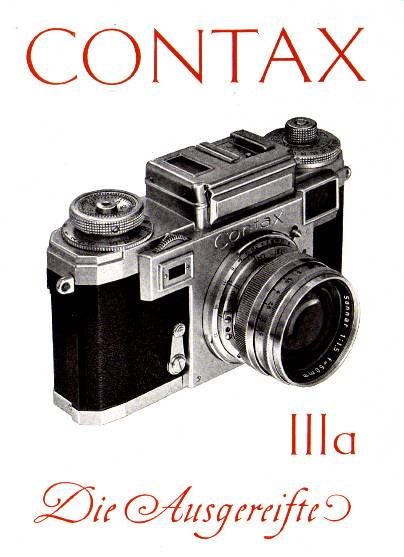 In 1961 Carl Zeiss stopped the production of the Contax and that was the end of the
production of rangefinder cameras by Carl Zeiss.
In 1961 Carl Zeiss stopped the production of the Contax and that was the end of the
production of rangefinder cameras by Carl Zeiss.
Already in 1953 carl Zeiss (West) made its first SLR : the Contaflex.
This camera had a central shutter and a fixed lens. This was the first camera with light metering behind the lens (TTL).
The later Contaflex cameras had the possibility to change lenses.
In 1958 the production of a professional camera was started : the CONTAREX
This really was a high quality product but the camera was rather ugly. Because the selenium lightmeter cell was placed in the middle of the pentaprism the Contarex was nicknamed the Cyclops.
But although ugly it was the first camera with a coupled lightmeter and with a matching needle visible in the viewer. The Contarex also had an instant return mirror.
But even with all his qualities the Contarex was no success because the Japanese manufacturers were selling very nice SLR cameras, like the Nikon F, at much lower prices.
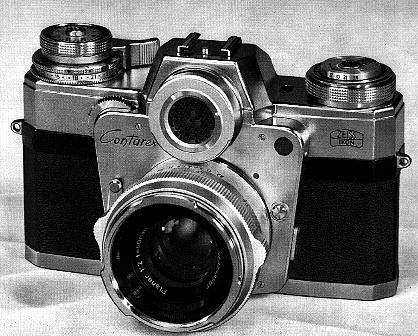
So Carl Zeiss marketed a downgraded version : the Contarex Special, followed by the Contarex Professional in 1966. These were both cameras without lightmeter.
In 1967 came the Contarex Super with TTL lightmetering and ultimately the Contarex SE (SE = Super Electronic).
The SE had a cloth shutter coupled to a solenoid. It also had the possibilty to add a motordrive for filmtransport and with the Tele Sensor this Contarex SE had the possibility to use diaphragm priority.
But even when it was clear that these cameras were the absolute top Carl Zeiss was not able to fight against the much cheaper Japanese SLR's. That is why Carl Zeiss looked for a partnership in Japan. Carl Zeiss would from then on only design cameras and the production would be done in Japan.
8. Carl Zeiss and YASHICA
Yashica was a manufacturer with a hugh capacity. Furthermore they had already experience in the field of camera electronics with the Yashica Electro 35 GSN rangefinder.
Carl Zeiss and Yashica decided to co-operate and started the Top Secret Project 130.
For this project they also included a third partner : the F. Alexander Porsche group. This group was experienced in ergonomic design and that was a real innovation in camera design at that time.
In 1974 at Photokina the results was shown : the CONTAX RTS (Real Time System). This was a totally electronic camera with an electronic shutter to 1/2000 sec, a winder for 2 images/sec or a motordrive for 5 images/sec.
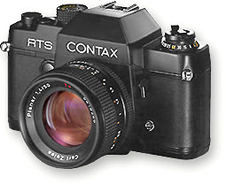 Although the camera had a tradional construction it offered the best quality on the market and the
influence of the Prosche designers was clearly felt in the ease of use.
After the RTS came the 139Q (1979) with a specially designed 45mm f2.8 Tessar and TTLflash metering.
Although the camera had a tradional construction it offered the best quality on the market and the
influence of the Prosche designers was clearly felt in the ease of use.
After the RTS came the 139Q (1979) with a specially designed 45mm f2.8 Tessar and TTLflash metering.The next Contax made by Yashica was the 137MD, the first camera with in-built motordrive. All the mechanical functions wer driven by micro-motors. The 137MD could be used as an automatic camera with diaphragm priority but manual operation was also possible with the AE lock. The 137MD was followed by the 137MA. This was a fuly manual camera with a motordrive for 3 images/sec.
The RTS II from 1982 was a totally new camera. The look was almost the same but inside it had up-to-date technology : TTL flash metering, quartz-controlled shutter speeds, titanium shutter blades, elctronic self timer,...
The Contax 159MM (MM = Multi Mode) was a totally renewed 139MD with a shutter speed of up to 1/4000 sec and a flash synchronisation of 1/250 sec. This camera had 5 possible operating modes : 3 preprogrammed + diaphragm priority + manual and the TTL flashsynchronisation was standard. The preprogrammed modes needed new MM lenses, but the old Contax lenses could still be used in manual mode.
The 159MM was followed by the 167MT (1987) a multi-mode program Contax with choice of spotmetering or matrix metering.
The RTS III finally was the long awaited professional camera : shutter speed up to 1/8000 sec, TTL flashmetering with any flashinstallation, pre-flash spotmeter, in-built motordrive for 5 images/sec, Real Time vacuum back with ceramic pressure plate to have a perfectly flat film.
The Contax S2 was made to celebrate 60 years of Contax cameras. The S2 was a simple camera with mechanical shutter and a diode-lightmeter with spotmetering. There was also a cantax S2b with integral light metering.
The Contax 167MT was further developed into the Contax ST. This camera featured a ceramic pressure plate, motor winder of 3 images/sec, flash synchronistaion at 1/200 sec and a little lighting device inside the viewer that made it possible to view the information even in unfavorable conditions.
Until then Carl Zeiss did not make any autofocus cameras. They showed a prototype at Photokina 1982 but this was not developed. The problem was that autofocus lenses need to be as light as possible. But for quality reasons at Carl Zeiss they just did refuse to use plastic parts.
The prototype of 1982 was eventually changed and was marketed as the Minolta 7000 (also called Maxxum 7000 and Dynax 7000)
In 1993 Zeiss produced a Contax camera that is a manual camera but with a digital focusing help. That was the Contax RX.
The focusing help is a graphic display in the viewfinder. The system marks the focus point and also the depth of field. The RX also gives the user the possibility to change the functions.
9. The Contax G1
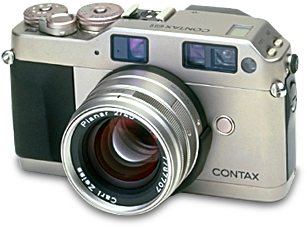
In 1994 the first Contax rangefinder with autofocus was launched : the G1.